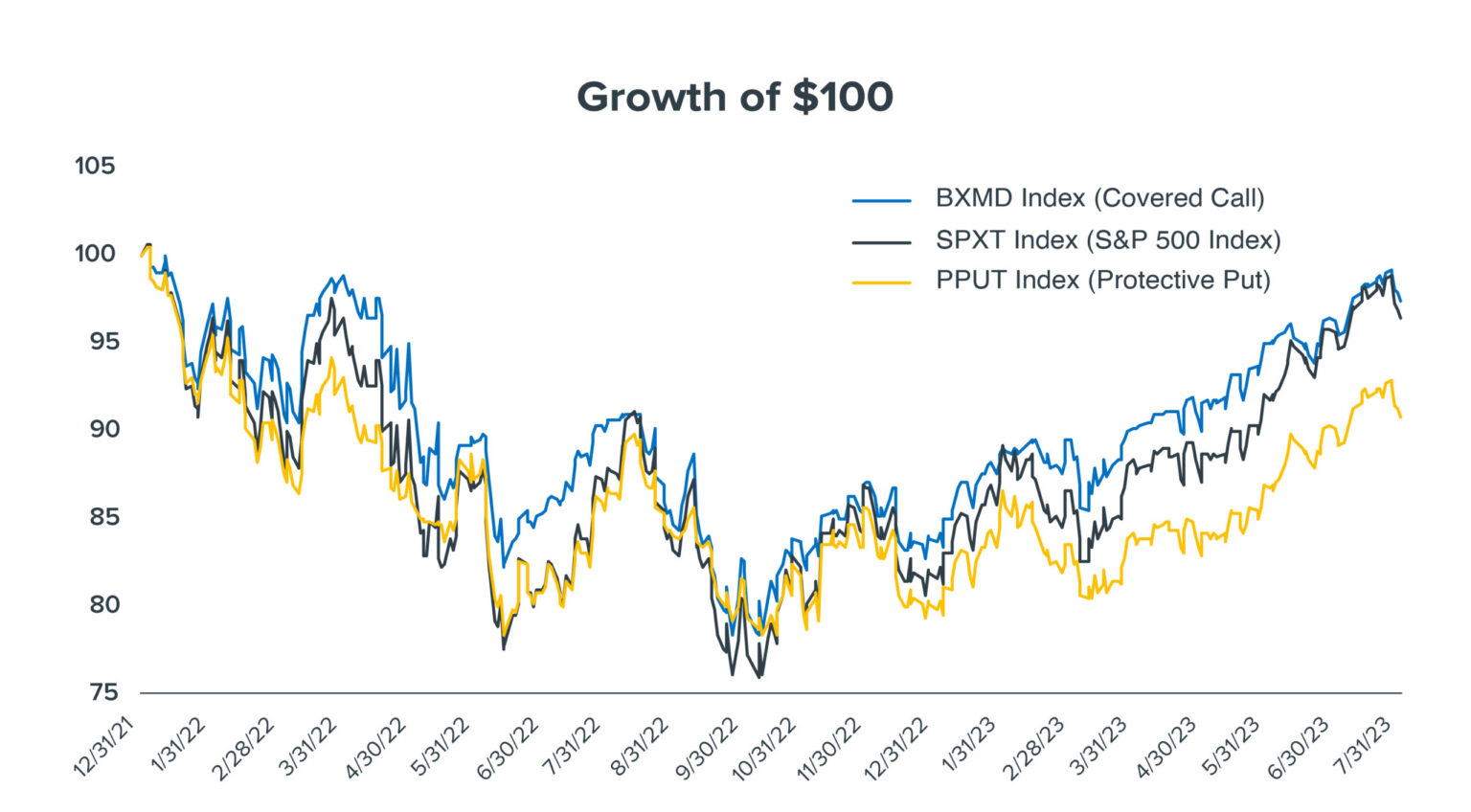A covered call strategy offers the potential for risk mitigation, current income, and outperformance.
Innovative strategies to mitigate risk and generate income are an important part of a strong goals-based investment plan. One such strategy to consider is a covered call approach, which has the potential to offer some distinct advantages over comparable strategies.
As seen in the chart below, a covered call strategy has outpaced protective puts (an alternative risk reduction strategy) by 6.6% and the S&P 500 index (by 1%) since the start of 2022.

To see why covered calls are outpacing both protective puts and the broader equity market itself, consider the differences between the two strategies:
- A covered call (represented by the Cboe S&P 500 30-Delta BuyWrite Index (BXMD) holds the S&P and sells a monthly out-of-the-money call option. By selling the call option, the covered call index’s upside potential is capped. However, this strategy generates option premiums that can be paid out as income while also striving to provide downside protection.
What’s more, those premiums actually increase when markets are volatile—potentially giving investors both more income and greater downside protection in challenging market environments. - A protective put (represented by the CBOE S&P 500 5% Put Protection Index (PPUT) also holds the S&P, but buys an out-of-the-money put option. Protective puts don’t pay out option premiums, which become more expensive as market volatility increases. That means they can pay off more than covered calls only if the market drops sharply and quickly.
Covered calls in range-bound markets with no strong moves in either direction offer the potential for above-average income levels and outperformance. So far this quarter, for example, the Cboe S&P 500 30-Delta BuyWrite Index leads the S&P 500 by just over 40 basis points, with the market up less than 1%.
Disclosures
This commentary is written by Horizon Investments’ asset management team.
Past performance is not indicative of future results.
Options are not suitable for all investors and carry additional risks. Options used in a strategy to reduce volatility and generate returns may not perform as intended and could expose the strategy to losses, e.g., option premiums, to which it would not have otherwise been exposed. Nothing contained herein should be construed as an offer to sell or the solicitation of an offer to buy any security. This report does not attempt to examine all the facts and circumstances that may be relevant to any company, industry, or security mentioned herein. We are not soliciting any action based on this document. It is for the general information of clients of Horizon Investments, LLC (“Horizon”). This document does not constitute a personal recommendation or take into account the particular investment objectives, financial situations, or needs of individual clients. Before acting on any analysis, advice, or recommendation in this document, clients should consider whether the security in question is suitable for their particular circumstances and, if necessary, seek professional advice. Investors may realize losses on any investments.
The S&P 500 or Standard & Poor’s 500 Index is a market-capitalization-weighted index of the 500 largest U.S. publicly traded companies. The Cboe S&P 500 30-Delta BuyWrite Index (BXMD) is a benchmark index designed to track the performance of a hypothetical covered call strategy that establishes a long position indexed to the S&P 500 Index (SPX Index) and writes a monthly Out-of-the-Money (OTM) SPX Call option. The Cboe S&P 500 5% Put Protection Index (PPUT) is a benchmark index designed to track the performance of a hypothetical risk-management strategy that consists of a long position indexed to the S&P 500 Index (SPX Index) and a long position in the monthly 5% Out-of-the-Money (OTM) SPX Put options. The Cboe S&P 500 30-Delta BuyWrite Index (BXMD) is a benchmark index designed to track the performance of a hypothetical covered call strategy that establishes a long position indexed to the S&P 500 Index (SPX Index) and writes a monthly Out-of-the-Money (OTM) SPX Call option. The distinctive feature of this index is, when writing the OTM SPX Call option, the option with a delta closest to 0.30 is selected. The BXMD Index does not use contributed input data, and all of the input data is readily available via public sources. The BXMD Index is non-significant, as defined by EU Regulation 2016/1011 (“EU Benchmark Regulation” or “EU BMR”). The Cboe S&P 500 5% Put Protection Index (PPUT) is a benchmark index designed to track the performance of a hypothetical risk-management strategy that consists of a long position indexed to the S&P 500 Index (SPX Index) and a long position in the monthly 5% Out-of-the-Money (OTM) SPX Put options. The PPUT Index does not use contributed input data, and all the input data is readily available via public sources. The PPUT Index is non-significant, as defined by EU Regulation 2016/1011 (“EU Benchmark Regulation” or “EU BMR”). Reference to an index does not imply that any account will achieve returns, volatility, or other results similar to that index. An index’s composition may not reflect how a portfolio is constructed in relation to expected or achieved returns, portfolio guidelines, restrictions, sectors, correlations, concentrations, volatility or tracking error targets, all of which are subject to change. Individuals cannot invest directly in any index. Indices are unmanaged and do not have fees or expense charges, which would lower returns.
The investments recommended by Horizon Investments are not guaranteed. There can be economic times when all investments are unfavorable and depreciate in value. Clients may lose money.
Asset allocation cannot eliminate the risk of fluctuating prices and uncertain returns. All investing involves risk of loss, and in periods of market growth, risk mitigation strategies can be expected to lag in performance behind equity strategies that do not focus on risk mitigation.
This commentary is based on public information that we consider reliable, but we do not represent that it is accurate or complete, and it should not be relied on as such. Opinions expressed herein are our opinions as of the date of this document. These opinions may not be reflected in all of our strategies. We do not intend to and will not endeavor to update the information discussed in this document. No part of this document may be (i) copied, photocopied, or duplicated in any form by any means or (ii) redistributed without Horizon’s prior written consent. Forward-looking statements cannot be guaranteed.
Other disclosure information is available at hinubrand.wpengine.com. Horizon Investments and the Horizon H are registered trademarks of Horizon Investments, LLC
©2023 Horizon Investments LLC
